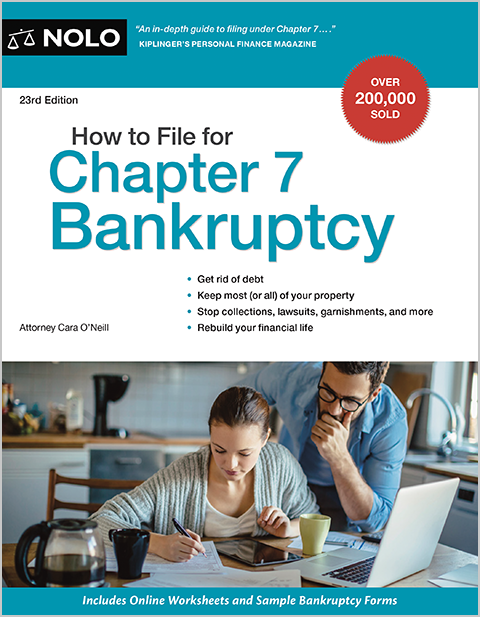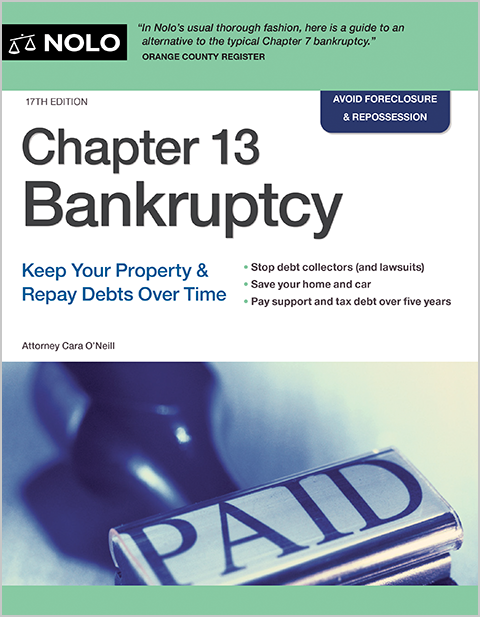Chapter 7 bankruptcy lets you keep or surrender your car or truck. Find out what will happen to your car in bankruptcy.
If you file for Chapter 7 bankruptcy and want to keep your car, truck, or motorcycle, you can do it. But you must meet particular criteria. In short, whether you keep or lose your car in Chapter 7 bankruptcy will depend on your answers to these questions:
- Do you want to let the car go or keep it?
- Do you own the vehicle outright, or is it financed?
- Are you current on the payment?
- Will your state let you keep all of your car equity in bankruptcy?
If it sounds like a lot, don't worry—we've simplified what you need to know about keeping and letting go of cars in Chapter 7, and you'll find more information about cars in Chapter 7 bankruptcy here.
- Walking Away: How to Surrender Your Car in Chapter 7
- How to Determine If You Can Keep Your Car in Chapter 7 Bankruptcy
- How to Check If Your Car Equity Is Protected
- How to Use the "Can You Keep Your Car in Chapter 7 Bankruptcy?" Chart
- Other Ways to Keep Your Car in Chapter 7 Bankruptcy
- Need More Bankruptcy Help?
Walking Away: How to Surrender Your Car in Chapter 7
We're going to start with an easy topic. It's possible to return your financed car to the bank and wipe out or "discharge" the loan. It's known as "surrendering" the vehicle.
You'll tell the Chapter 7 court, the Chapter 7 trustee managing your case, and your lender that you want to surrender your car on a bankruptcy form called the Statement of Intention for Individuals Filing Under Chapter 7 Bankruptcy. You'll use the same form to let go of a leased car.
But if your mom, uncle, or friend helped you get the loan, you'll want to find out if your cosigner will have to pay your debt if you file for Chapter 7 and surrender your car. The quick answer? Yes.
How to Determine If You Can Keep Your Car in Chapter 7 Bankruptcy
Figuring out whether you'll keep or lose your car in Chapter 7 bankruptcy is more complicated than checking a "Surrender the property" box. To make things easier, we've created a chart to refer to while learning how this works.
"Can You Keep Your Car in Chapter 7 Bankruptcy?" Chart
|
|
Equity Protected |
Equity Not Protected |
|
No Car Loan |
Keep the car in Chapter 7 bankruptcy. |
Lose the car in Chapter 7 bankruptcy—consider Chapter 13. |
|
Car Loan and Payment Is Current |
Keep the car in Chapter 7 bankruptcy. |
Lose the car in Chapter 7 bankruptcy—consider redemption or Chapter 13. |
|
Car Loan and Payment Is Past Due |
Lose the car in Chapter 7 bankruptcy—consider redemption or Chapter 13. |
Lose the car in Chapter 7 bankruptcy—consider redemption or Chapter 13. |
How to Check If Your Car Equity Is Protected
- Determine your car's value.
- Subtract any balance owed on a car loan.
- Check whether a bankruptcy exemption protects the property equity.
Here are the instructions for each step.
Your car's value is the amount someone would pay to buy it. Find out how much it's worth using Kelley Blue Book or the NADA website.
If you own your car outright, you'll skip the second step. Otherwise, subtract your loan balance from your car's value. The result is your vehicle equity—the amount you'd keep if you sold your car, truck, or another vehicle. You must subtract the loan amount because no one—not you or the bankruptcy trustee—can sell the car without paying off the loan. Period.
The third step requires you to check your state's bankruptcy exemption statutes. Exemption statutes are the laws that tell you the property you can keep in bankruptcy. If the property tends to have a higher value—think cars and homes—the exemption will explain how much property equity you can protect. If you can't cover all of your equity, you'll lose the property in Chapter 7.
You'll find your state's bankruptcy exemptions here. Look for a motor vehicle exemption—it specifically protects cars and other vehicles. Also, check for a wildcard exemption. Most states will let you use both if the motor vehicle exemption isn't enough to protect your car in bankruptcy.
How to Use the "Can You Keep Your Car in Chapter 7 Bankruptcy?" Chart
Do you have your figures? Great! You're ready to use the chart. But first, take a second to notice that you'll lose your car in Chapter 7 bankruptcy when:
- you can't protect the equity, or
- you're behind on your car payment.
The reason in both situations is essentially the same.
Chapter 7 is quick and wipes out qualifying debts in about four months without requiring you to pay anything to creditors. Because it's quick, you won't have time to catch up on your car payment or pay to keep a car with a lot of nonexempt equity. That's what Chapter 13 bankruptcy is for—it lets you fix these problems using the three- to five-year Chapter 13 payment plan.
In Chapter 7, the trustee will sell your car if you can't protect the equity and give you the exemption amount. And if you're not current on the car loan when you file for Chapter 7, the lender will use its lien rights to get it back by either:
- asking the bankruptcy court to lift the automatic stay that stops collections so the lender can repossess the car during bankruptcy, or
- waiting until the bankruptcy case ends to repossess the vehicle.
Now that you understand the elements, check the chart. You'll learn more about redemption below.
Other Ways to Keep Your Car in Chapter 7 Bankruptcy
If your car is worth less than you owe, you can pay its current value and keep it using "redemption." Also, you can use a "reaffirmation agreement" to reestablish your payment contract with the lender.
Pay Less for a Financed Car Using Chapter 7 "Redemption"
Suppose you owe $10,000 on your car loan, but the car is worth only $5,000. You can redeem the loan by paying the lender $5,000 to keep your vehicle free and clear.
The benefit of redemption is you'll pay less if you owe more than the car is worth. It will also fix a late payment problem—you'll either own the car or be current after financing with another lender.
The downside? You must pay the current value in full in one payment. You'll need to use funds you protected with a bankruptcy exemption when you filed or money earned, given to you, or borrowed after filing your bankruptcy case. Some people turn to friends, family, or a lender specializing in redemption loans—but it's not cheap. You should count on getting a high-interest rate.
"Reaffirm" Your Car Loan in Chapter 7 Bankruptcy
Some lenders will allow you to keep the car without doing anything other than staying current on your payment. The lender will transfer the vehicle title to you once you pay it off.
Many courts prefer that filers take this route because if you can't pay any longer, or if the car stops working, you can return it to the lender owing nothing. However, you won't get credit for payments on your credit report, and you could lose the car without warning because the lender can repossess the vehicle at any time.
A reaffirmation agreement is a new contract that lets you keep your vehicle under the same terms as your original car's promissory note. It protects filers because the lender can't repossess it unless you break the contract terms.
However, you'll be responsible under its terms after your bankruptcy ends. So if you have to give the car back and you owe more than it's worth—for example, you owe $25,000, but it's worth $15,000—you'll be on the hook for the $10,000 deficiency balance.
Keeping Your Car Using The Reaffirmation Process in Chapter 7 Bankruptcy
If you say you want to keep a financed car in your bankruptcy papers, the lender will send you a reaffirmation agreement with the same terms as your old deal.
Negotiating the reaffirmation agreement. You have some negotiation leverage. The lender knows you can surrender the car and cancel all liability, and banks lose money on repossessions. Consider asking the lender to reduce the loan to the car's current value—all the lender can do is refuse. You can also request that your lender incorporate past-due payments into the agreement. Still, again, your lender is under no obligation to modify your payment when you're behind.
Getting court approval of the reaffirmation agreement. After agreeing on the terms, you'll sign and file the reaffirmation agreement with the bankruptcy court. The judge will decide whether the reaffirmation agreement is in your best interests at a hearing by considering your income, the amount you owe, and the car's value. The judge might decide that the reaffirmation will create an undue hardship for you or your family and disallow it if you still owe significantly more than the car's value or if it would be a struggle to make the payment.
Your attorney can approve the reaffirmation agreement. Your bankruptcy attorney can sign the reaffirmation agreement attesting that it is in your best interests, which will let you avoid the hearing. The court will automatically approve it.
Need More Bankruptcy Help?
Did you know Nolo has made the law accessible for over fifty years? It's true, and we want to ensure you find what you need. Below, you'll find more articles explaining how bankruptcy works. And don't forget that our bankruptcy homepage is the best place to start if you have other questions!
|
Our Editor's Picks for You |
|
|
More Like This |
Can the Lender Repossess My Car During Chapter 7 Bankruptcy? |
|
Consider Before Filing Bankruptcy |
Chapter 7 Bankruptcy—Who Can't File? |
|
Helpful Bankruptcy Sites |
We wholeheartedly encourage research and learning, but online articles can't address all bankruptcy issues or the facts of your case. The best way to protect your assets in bankruptcy is by hiring a local bankruptcy lawyer.
|
|
- Walking Away: How to Surrender Your Car in Chapter 7
- How to Determine If You Can Keep Your Car in Chapter 7 Bankruptcy
- How to Check If Your Car Equity Is Protected
- How to Use the “Can You Keep Your Car in Chapter 7 Bankruptcy?” Chart
- Other Ways to Keep Your Car in Chapter 7 Bankruptcy
- Need More Bankruptcy Help?

